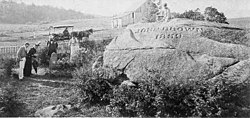John Brown Farm State Historic Site
John Brown Farm State Historic Site | |
 John Brown's grave, 1896, S R Stoddard. | |
| Nearest city | Lake Placid, New York |
|---|---|
| Coordinates | 44°15′08″N 73°58′18″W / 44.252240°N 73.971799°W |
| Area | 270 acres (110 ha) |
| Built | 1849 |
| NRHP reference No. | 72000840 |
| Significant dates | |
| Added to NRHP | June 19, 1972[1] |
| Designated NHL | August 6, 1998[2] |
The John Brown Farm State Historic Site includes the home and final resting place of abolitionist John Brown (1800-1859). It is located on John Brown Road in North Elba near Lake Placid, New York, where John Brown moved in 1849 to lead freed slaves in farming. It was declared a National Historic Landmark in 1998.[2][3] It has been managed by the state since 1896; the grounds are open to the public on a year-round basis, and tours of the house are offered in the warmer months.
Description and history
The John Brown Farm is located south of the village of Lake Placid, between the village of North Elba and the Lake Placid Airport on John Brown Road. The property is 270 acres (110 ha) in size, of which the northern third houses the developed part of the site, with the balance in now reforested hills. The developed area includes John Brown's farmhouse and barn, as well as a caretaker's house and other infrastructure for visitors. The family graveyard is also part of the site, encircled by an iron fence. A statue of John Brown, placed in 1935, stands nearby. The house is a 2-1/2 story timber framed structure, with a gable roof and clapboarded exterior. Its front is four bays wide, with the entrance in the left center bay, topped by a transom window. Most of the finishes, both interior and exterior, are restorations performed in the second half of the 20th century to bring about a c. 1860 appearance.[3]
John Brown arrived in upstate New York in 1848, as part of a project funded by Gerrit Smith to assist freed slaves in the learning to become self-sufficient farmers. Pursuant to that end, he and his sons purchased this land in 1850.[3] In 1855, Brown moved to Kansas to support his sons' efforts to keep Kansas as a free-state under the popular sovereignty laws, leaving his wife and several of his children behind. Brown returned to visit his family at Lake Placid several times. In 1859, Brown attempted to start a liberation movement among enslaved African Americans by seizing the arsenal at Harpers Ferry, Virginia (now West Virginia). For this, he was tried for treason against the state of Virginia and hanged. The family sold the property (except for the graveyard) in 1863. In 1870 it was purchased by journalist Kate Field, who formed an association to oversee its preservation and make it accessible to visitors. It was acquired by the state in 1896.[3]
Gallery
-
Sculpture by Joseph Pollia
-
Farmhouse
-
John Brown's Tombstone, North Elba
-
Parlor in John Brown's Farmhouse
-
Kitchen
-
First floor Bedroom
-
2nd Floor Bedroom
See also
- List of New York State Historic Sites
- List of National Historic Landmarks in New York
- List of reference routes in New York
References
- ^ "National Register Information System". National Register of Historic Places. National Park Service. January 23, 2007.
- ^ a b "John Brown Farm and Gravesite". National Historic Landmark summary listing. National Park Service. September 11, 2007. Archived from the original on June 6, 2011.
{{cite web}}: Unknown parameter|deadurl=ignored (|url-status=suggested) (help) - ^ a b c d Gobrecht, Lawrence E. (November 21, 1997). "National Historic Landmark Nomination: John Brown Farm and Gravesite" (pdf). National Park Service.
{{cite journal}}: Cite journal requires|journal=(help) and Accompanying 9 photos, exterior, from 1996. (1.59 MB)
External links
- Official website
- New York History Net, John Brown's Farm
- Aboard the Underground Railway: John Brown Farm and Gravesite, at National Park Service
- Exhibit about Timbucto, the "Freed Slave Utopian Experiment"
- Historic American Buildings Survey (HABS) No. NY-245, "John Brown Farm State Historic Site, Farmhouse, State Route 73 (North Elba Township), Lake Placid vicinity, Essex County, NY", 6 measured drawings
- Houses on the National Register of Historic Places in New York (state)
- New York state historic sites
- National Historic Landmarks in New York (state)
- John Brown (abolitionist)
- Museums in Essex County, New York
- Houses completed in 1849
- Historic house museums in New York (state)
- Biographical museums in New York (state)
- Slavery in the United States
- Parks in Essex County, New York
- Houses in Essex County, New York
- Adirondack Park
- Historic American Buildings Survey in New York (state)
- 1849 establishments in New York (state)
- Lake Placid, New York
- National Register of Historic Places in Essex County, New York











